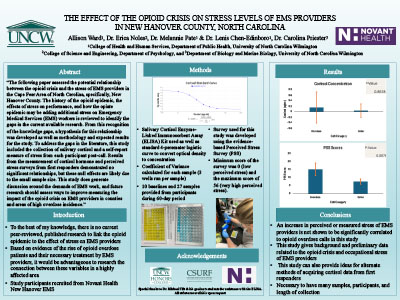ABSTRACTS
The Effect of the Opioid Crisis on Stress Levels of EMS Providers in New Hanover County, North CarolinaAuthor: Allison Ward, Carolina Priester, Erica Noles, Melannie Pate, and Lenis Chen-Edinboro | | Associate Authors:
Introduction: The history of the opioid epidemic, the human stress response, and how the opiate epidemic may be adding additional stress on emergency medical services (EMS) workers is reviewed to identify the gaps in the current research. This study was approved by the UNCW IRB, #H23-0560, as well as the Novant Health IRB, #23-2484. Objective: To assess the potential relationship between the opioid crisis and the stress of EMS providers in New Hanover County, North Carolina. Methods: To address the gaps in the literature, this study included the collection of salivary cortisol and a self-report measure of stress from each participant post-call. After recruitment, 10 volunteers from New Hanover EMS participated in the study. Most participants were paramedics with varying experience but many had multiple years working in EMS. Saliva samples were assessed using an ELISA assay and checked for validity by calculating a coefficient of variance for each sample. Perceived stress surveys were scored by calculating the responses associated with positive and negative questions. Data were assessed using JMP software to run two independent t-tests and an ANOVA. Results: Twenty-seven perceived stress survey responses and 26 valid saliva collections were obtained over the 60-day collection period. Results from the measurement of cortisol and perceived stress surveys from first responders demonstrated no significant relationships, but these null effects are likely due to the small sample size. A notable trend was observed when comparing the perceived stress of providers on overdose calls in comparison to all other calls, with the mean perceived stress responses being double that of all other calls and having a p-value of .0878. Conclusion: This study generates discussion around the demands of EMS work, and future research should assess ways to improve measuring stress so that there may be an increase in response. Further research should be encouraged in this area to establish correlations and bring awareness to the opioid epidemic as well as the occupational stress of being a first responder, especially given the relationship between perceived stress and opioid calls demonstrated in this study.
|

